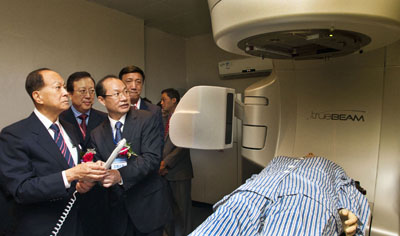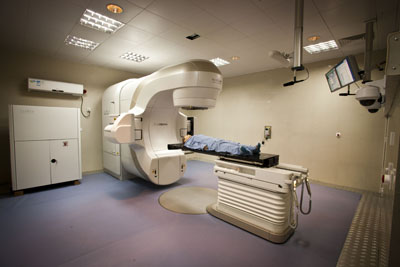
faster and higher-precision radiotherapy to battle cancer
(Shantou and Hong Kong, 30 June 2011) Shantou University Medical College's Affiliated-Cancer Hospital is China's proud first adopter of the state-of-the-art TrueBeam system - an innovative fully-integrated system for fast and precise image-guided radiotherapy that could radically advance the treatment of lung, breast, prostate, head and neck, and other types of cancer.
A dedication ceremony has been held recently at the affiliated hospital to celebrate the completion of installation of this important gift that the Li Ka Shing Foundation (LKSF) donated to the College.
Speaking at the dedication ceremony, Director of the Affiliated-Cancer Hospital of the STU Medical College Professor Zhang Guojun said TrueBeam's small, high-intensity fields of radiation would be a great addition to the hospital's full line of cancer treatment technologies.
"This new technology, combined with our physicians' expertise and commitment in patient care, will offer a new chapter of possibilities for our cancer treatments in our long and hard battle against cancer," Professor Zhang said.
Since its founding in 1994, the cancer hospital has been committed to providing cancer patients with the best multimodality treatment including chemotherapy, surgeries and radiotherapy.
The hospital is equipped with eight operating rooms and 11 wards with 416 beds for patients, served by 120 physicians and 74 medical technicians of different expertise. With its modern diagnostics, the hospital each year treats over 75,000 out-patients and 14,000 in-patients, as well as performing close to 4,000 operations.
Faster Treatments
TrueBeam is designed to treat tumors with speed and accuracy, including tumors that move during treatment as the patient breathes in and out. The system features a multitude of technical innovations that dynamically synchronises imaging, patient positioning, motion management and treatment delivery during sophisticated treatments for cancer.
With its high intensity mode, TrueBeam can deliver high doses quickly and accurately, more than twice as fast as earlier generations of technology. This makes it possible to significantly shorten treatments, potentially enabling clinics to treat more patients each day and to improve precision by leaving less time for tumor motion during dose delivery.
The "intelligent" automation of TrueBeam further speeds treatments with an up to five-fold reduction in the number of steps needed for image guidance and dose delivery. Simple treatments that once took 15 minutes or more can be completed in less than two minutes once the patient is in position. Reducing treatment times also increases treatment accuracy, since patient movement is reduced.
Enhanced Precision
TrueBeam's precision is measured in increments of less than a millimeter. This accuracy is made possible by the system's sophisticated architecture that synchronises imaging, patient positioning, motion management, beam shaping and dose delivery, performing accuracy checks every 10 milliseconds throughout the entire treatment. Critical data points are measured continually as a treatment progresses, ensuring that the system maintains a "true isocenter" or focal point of treatment.
Faster Imaging at Lower Doses
TrueBeam's imaging technology can produce three-dimensional images to fine tune tumor targeting in 60 per cent less time. Additional functionality makes it possible to create images with 25 per cent less X-ray dose. TrueBeam can be used for radiotherapy treatments, including image-guided radiotherapy and radiosurgery treatments.
Collaboration with Stanford University
The School of Medicine of Stanford University also received support from LKSF in 2010 for its acquisition of a TrueBeam system and began patient treatment in the latter half of 2010. A long-term partner of STU, Stanford has provided training for STU doctors in the use of this most advanced technology available for radiosurgery and will explore co-operations in clinical studies.
Dr Frieda Law, Executive Director of LKS STU Foundation and Consultant of STU's Medical College, said radiotherapy as a method of cancer treatment had been very well developed in the affiliated cancer hospital.
"This new TrueBeam system, being the first in the Greater China Region, will definitely upgrade our gear in our fight against cancer, and enable our doctors to strengthen their scientific collaborations with our counterparts in Stanford University," Dr Law said.
 |
| 1. With Mr Hao Ping (second left), Vice Minister of Education of China and Professor Gu Jiang (first right), Dean of STU Medical College, Mr Li Ka-shing tries to understand more about the operation of the TrueBeam system from Professor Zhang Guojun (second right), Director of the Affiliated-Cancer Hospital. |
 |
| 2. Installation of the state-of-the-art radiotherapy system, TrueBeam, has completed at the STU Medical College Affiliated-Cancer Hospital and will soon be ready to treat its first cancer patient. |
About the Li Ka Shing Foundation
The Li Ka Shing Foundation was established in 1980 by global entrepreneur and philanthropist Li Ka-shing. Mr Li considers the Foundation to be his "third son" and has pledged one-third of his assets to it. To date, the Foundation has granted over HK$12.5 billion (US$1.6 billion) in charitable donations, approximately 90 per cent of which has gone to the Greater China region.
The Foundation supports projects that propel social progress and create a cycle of charity in the world through expanding access to quality education and healthcare, encouraging cultural diversity and exploration, and stimulating community involvement and sustainable development. For more information, please visit: http://www.lksf.org.
For inquiries, please contact:
Li Ka Shing Foundation
Jeremy Lau
Tel: 2128 1207
Email: jeremyl@hwl.com.hk